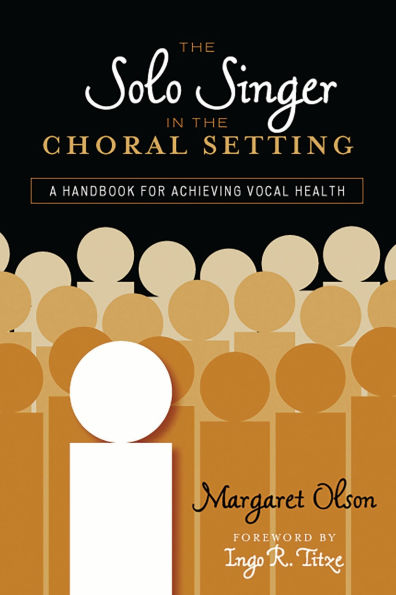While there are many similarities between solo and choral singing, they are not the same discipline, and it is important to realize the different approaches necessary for each. In The Solo Singer in the Choral Setting: A Handbook for Achieving Vocal Health, Olson presents the unique perspective of choral singing from a soloist's viewpoint, providing a clear outline of several issues facing the solo singer in the choral setting. She discusses concepts as diverse as body position in rehearsal and acoustic sound production, and she offers practical ideas for solving these challenges. Teaching examples and case studies help illustrate the problems and offer potential solutions for handling the challenges of the choral environment.
After a general overview of vocal technique, the chapters address the physiological, psychological, pedagogical, acoustic, and interpretive issues facing the solo singer in the choral setting. Concepts, such as phonation; resonation and timbre; approaches to diction; voice classification; choral blend; interpreting emotion; relationships among choral conductor, singer, and teacher of singing; and the use of vibrato are examined in detail. Concluding with a conversation with two choral conductors, as well as a glossary, bibliography, and index, this volume is beneficial to singers, teachers, and conductors alike.
1100312096
After a general overview of vocal technique, the chapters address the physiological, psychological, pedagogical, acoustic, and interpretive issues facing the solo singer in the choral setting. Concepts, such as phonation; resonation and timbre; approaches to diction; voice classification; choral blend; interpreting emotion; relationships among choral conductor, singer, and teacher of singing; and the use of vibrato are examined in detail. Concluding with a conversation with two choral conductors, as well as a glossary, bibliography, and index, this volume is beneficial to singers, teachers, and conductors alike.
The Solo Singer in the Choral Setting: A Handbook for Achieving Vocal Health
While there are many similarities between solo and choral singing, they are not the same discipline, and it is important to realize the different approaches necessary for each. In The Solo Singer in the Choral Setting: A Handbook for Achieving Vocal Health, Olson presents the unique perspective of choral singing from a soloist's viewpoint, providing a clear outline of several issues facing the solo singer in the choral setting. She discusses concepts as diverse as body position in rehearsal and acoustic sound production, and she offers practical ideas for solving these challenges. Teaching examples and case studies help illustrate the problems and offer potential solutions for handling the challenges of the choral environment.
After a general overview of vocal technique, the chapters address the physiological, psychological, pedagogical, acoustic, and interpretive issues facing the solo singer in the choral setting. Concepts, such as phonation; resonation and timbre; approaches to diction; voice classification; choral blend; interpreting emotion; relationships among choral conductor, singer, and teacher of singing; and the use of vibrato are examined in detail. Concluding with a conversation with two choral conductors, as well as a glossary, bibliography, and index, this volume is beneficial to singers, teachers, and conductors alike.
After a general overview of vocal technique, the chapters address the physiological, psychological, pedagogical, acoustic, and interpretive issues facing the solo singer in the choral setting. Concepts, such as phonation; resonation and timbre; approaches to diction; voice classification; choral blend; interpreting emotion; relationships among choral conductor, singer, and teacher of singing; and the use of vibrato are examined in detail. Concluding with a conversation with two choral conductors, as well as a glossary, bibliography, and index, this volume is beneficial to singers, teachers, and conductors alike.
60.3
In Stock
5
1

The Solo Singer in the Choral Setting: A Handbook for Achieving Vocal Health
220
The Solo Singer in the Choral Setting: A Handbook for Achieving Vocal Health
220Related collections and offers
60.3
In Stock

Product Details
| ISBN-13: | 9780810869141 |
|---|---|
| Publisher: | Bloomsbury Publishing |
| Publication date: | 11/04/2010 |
| Sold by: | Barnes & Noble |
| Format: | eBook |
| Pages: | 220 |
| File size: | 887 KB |
About the Author
From the B&N Reads Blog
